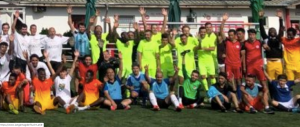24 October 2019*
On September 27th, I had the privilege of playing soccer alongside refugees in a tournament that was part of “Langer Tag der Flucht” (long day of the escape), a full day event devoted to the stories of refugees in Vienna, Austria. As I was enjoying the sport I love and practicing my amateur German, I had to face a difficult truth: all but one of my teammates are going to be sent back to the country they fled from in one week. Their applications for asylum were rejected.
 For the past seven weeks I have been living in Vienna as part of the Europe and Morocco Cross-Cultural. While I am here I am volunteering with Caritas, a Non-Government Organization (NGO) with roots in the Catholic Church. Part of Caritas’ mission is refugee aid, and I was fortunate to spend every Monday working alongside staff at Haus Erdberg, a refugee complex housing around 250 refugees.
For the past seven weeks I have been living in Vienna as part of the Europe and Morocco Cross-Cultural. While I am here I am volunteering with Caritas, a Non-Government Organization (NGO) with roots in the Catholic Church. Part of Caritas’ mission is refugee aid, and I was fortunate to spend every Monday working alongside staff at Haus Erdberg, a refugee complex housing around 250 refugees.
The residents here are either single men or families, and they come from all different walks of life. I helped with organizing the line for their weekly allowance, and shadowed staff as they replaced residents’ light bulbs, furniture and bedding etc..
Immigration is one of Austria’s most pressing and controversial issues. In 2015, there was a surge of migrants from the Middle East, flowing into many European countries, including Austria. Germany’s Chancellor Angela Merkel’s main slogan regarding migration at the time was “wir schaffen das”, or “we can do it”, and as a result, between 2015 and 2016, one million migrants entered Europe through the gateway of Austria, an eighth of the nation’s population. Only around 100,000 immigrants stayed in Austria; the remainder migrated to other European countries or went overseas. The influx of immigration has since decreased since 2015, but migration statistics show that it could be on the rise again.
For the average refugee coming to Vienna, the journey to safety and freedom is a long and grueling one. People coming to Vienna must apply for asylum upon entry. Those seeking asylum must live in a refugee center, where they cannot work or travel, until they are notified about that status of their application. This waiting period can be as short as six months, although it is on average around 16 months, according to the Austrian Ministry of Domestic Affairs. Those seeking asylum at Haus Erdberg wait three years on average.
Through volunteering at Caritas, I saw Vienna through a different lens. The building is not an old beautiful Catholic cathedral, nor is it a world-class performance venue. There are around 250 residents in the center, all of whom are waiting to see if they will be invited in, or if they will be sent back to their home country from whence they fled. While they are at the center, these asylum seekers must learn German, so that if they are granted asylum and are allowed to work, they are able to find a job. Most jobs in Austria require at least a B2 German level, which is attainable through an exam, which tests reading, writing, speaking, and listening in German. Even after asylum is granted, there are still a lot of obstacles. For example, a refugee’s education is not always recognized by the authorities, thus making their resume unattractive to employers.
Despite these challenges, there are ways for refugees to integrate into Austrian society. As a group, we got the opportunity to visit and tour the Magdas Hotel, a social organization specifically employing refugees to work as receptionists, chefs, and other positions. As a whole, the Magdas (meaning “like that” in German) employees represent 14 different nations and 23 languages. As a refugee, this job is an excellent way to get a foot in the working world and gain experiences that can lead to a steady job in Austria.
My father was a refugee. He fled Vietnam in 1981 and came to the US speaking little to no English with virtually no money on him. He was fortunate to have missionaries sponsor him in Florida. Without them he could not have found a home in this country, and he would not have met my mom (an EMU alum), and my brothers and I would not exist. I acknowledge that immigration is a complex issue, however, Austria is endearing to me not in spite of its refugees, but because of them, and the gifts they bring to the nation. I want refugees to be seen as human, just as my dad was, and I want others to experience the Vienna I have loved during my time here.
My time in this country has been extremely positive. Vienna city life is exciting and addicting. It has a beautiful café culture, an incredibly efficient public transportation system, one of the world’s best theater scenes, and is visually stunning at every corner. Learning about the politics and issues here does not make me like this place less, it makes me care about it more.
After reading EMU’s Common Read Exit West [Mohsin Hamid] this summer, I have resonated with it immensely while learning about European history during my time abroad. One line continues to stick out for me: “We are all migrants of time.”
-Avery Trinh
*This article originally published by The WeatherVane Nov. 7, 2019

